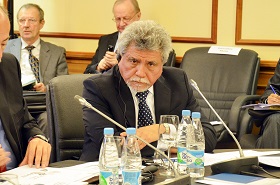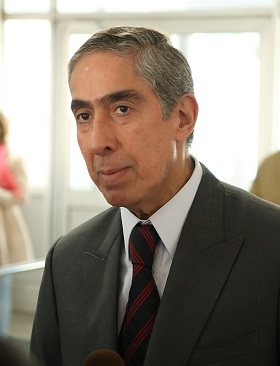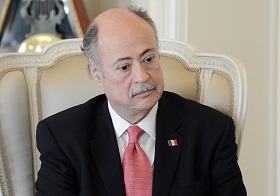The Pacific Alliance: History, Goals, Relations with Observer States, Achievements
In
Login if you are already registered
(no votes) |
(0 votes) |
On September 30, 2014 RIAC held a roundtable on Russia-Pacific Alliance relations organized together with the Mexican embassy in Moscow. A very lively and dynamic, this event brought together a significant number of scientists, historians and academicians. Among the high-level guest were Mexican ambassador to Russia Ruben Beltran, Gustavo Otero of Peru and Jaime Giron of Colombia.
On September 30, 2014 RIAC held a roundtable on Russia-Pacific Alliance relations organized together with the Mexican embassy in Moscow. A very lively and dynamic, this event brought together a significant number of scientists, historians and academicians. Among the high-level guest were Mexican ambassador to Russia Ruben Beltran, Gustavo Otero of Peru and Jaime Giron of Colombia.
— La Alianza del Pacífico: Origen, objetivos, relación con países observadores y logros
Background of the Pacific Alliance
Gustavo Otero, Ambassador Extraordinary and Plenipotentiary of Peru to Russia
In 2010, then Peruvian president Alan Garcia proposed the establishment of a regional integration mechanism, an idea that was immediately supported by Peru's key economic partners. In 2007, the so-called Pacific Arc emerged, uniting eleven littoral states wanting to cooperate with Southeast Asia. However, the forum turned out to be a low-key affair, mostly because of differences in trade policy. At the same time, the initiative has laid the foundation for the process that has created the Pacific Alliance.
Therefore, in October 2010, President Garcia invited his counterparts from Colombia, Chile, Ecuador and Panama to discuss the strengthening of the deep integration area that would provide for free movement of goods, services, capital and labor. The idea was aimed at the transformation of this space into a regional integration model that would assist the consolidation of the overall economic platform for engagement with the outside world, first of all with Asia.
From December 2010 to March 2011, the presidents, foreign ministers and foreign trade ministers of Chile, Colombia, Mexico and Peru discussed the project at the bilateral level in order to outline a roadmap that would cover both traditional trade issues and other integration aspects.
The Pacific Alliance was launched at the Lima Summit on April 28, 2011 through the signing of a declaration that proclaimed a mechanism for the enhanced integration of the Latin American Pacific Arc, as well as that would enable growth, development and improved competitiveness of those economies striving to establish links with Asia-Pacific. Panama attended the summit as an observer.
The declaration was the first official document to reflect the common vision of the venture which obliged the founding countries to gradually allow for the free movement of goods, services, capital and labor. A focus was also placed on the movement of entrepreneurs, simpler migration transit, a better trading environment, customs cooperation and improved dispute settling mechanisms.
Launched by the Lima Declaration, the process culminated in June 2012, when the site of Paranal Observatory in Antofagasta, Chile, was used to sign the Framework Agreement on the Pacific Alliance.
The Agreement states that the four countries of the Pacific Arc group will become members of the Pacific Alliance, with Costa Rica soon also completing the process. Panama has held observer status of the Alliance since its establishment, while Honduras, Guatemala, Salvador and Ecuador are also observers. In total, there are ten full-fledged participants and observers.
Although the four member states share many commonalities in their economic policies, their levels of development and social problems differ. However, this fact has not hampered the implementation of key objectives on the basis of consensus, and the economic cooperation of the four member states has been progressing at a breakneck speed.
Since the launch of the initiative in Peru in 2011, we have seen much evidence attesting to the firm political will aimed at promoting the Alliance, with a conviction in its ultimate success shared by the leaders of all four countries. Despite leadership changes in our countries in recent years, the political will for advancing the Alliance has been invariably durable, thanks to the shared fervor for integration. And state policies are being responsibly pursued by all members of the organization.
Peruvian President Ollanta Humala stated that despite the positive progress made by the Alliance, steps should be continued to fight inequality, which remains a major challenge for all of Latin America. He added that the main task lies in opening markets for the populations of our countries, so that the broad masses of Latin Americans can rise to prosperity.
The Pacific Alliance vis-à-vis Observer Countries and other Integration Mechanisms (APEC, Trans-Pacific Partnership)
Jaime Giron, Ambassador Extraordinary and Plenipotentiary of Colombia to the Russian Federation
The Pacific Alliance is definitely interested in dynamic and productive relations with the rest of the world.
And this process is already underway. Along with Panama and Costa Rica, who are candidate observers, there are thirty additional states holding observer status, coming from the Americas, Africa, Europe, Asia and Oceania.
Observer status has been granted to states that share the principles and objectives stipulated by the Framework Agreement, while candidate observers are those willing to become full members. In order to develop vibrant and productive ties with its observers, the Pacific Alliance has set up individual cooperation mechanisms in areas of common interest that take into account the priorities of the Alliance.
Relationships with observers are built through projects, programs and proposals for cooperation in various fields with a focus on education, trade, SME, innovations, science and technology, infrastructure, as well as the search for adequate and effective access to global markets, particularly in the Asia-Pacific region.
In order to approve a working program for engaging observers, third parties and other regional forums, the Pacific Alliance has established the Working Group on External Ties that arranges meetings and communications with the observer states.
On April 7-8, 2014, in Lima, the Working Group held a meeting with the first set of observers to cover education, trade assistance and SME promotion. On October 7-8, 2014, a second gathering took place with another group of observers in Vina del Mar, Chile.
On June 20, 2014, during the 9th Summit of the Pacific Alliance, the Council of Ministers arranged a high-level event, i.e. a conference of delegations from 32 observer states, to discuss the key achievements of the group, as well as opportunities and areas for cooperation.
Representatives of the Alliance member countries also ratified the Framework Agreement, which outlines a set of obligations for strengthening various integration mechanisms in Latin America and builds a space for cooperation and rapprochement aimed at bolstering open regionalism. They have also reiterated their desire to promote effective engagement of all sides in the globalized world and participation in other initiatives within the scope of regional cooperation.
They agreed to hold a ministerial designed to inform its participants about ties with Mercosur, and a symposium bringing together academics, businessmen and top officials of the Pacific Alliance, Mercosur and countries of the region, including Central America and the Caribbean, to take place on November 24, 2014 in Santiago, Chile.
The Pacific Alliance also has various plans for interaction with the OECD, the Inter-American Development Bank and the Development Bank of Latin America.
The Pacific Alliance is initiating contacts with the Customs Union of the Eurasian Economic Union, as the Colombian ministers for foreign affairs and foreign trade met with Chairman of Eurasian Economic Commission Board Viktor Khristenko during the 5th Intergovernmental Russian-Colombian Commission to consider opportunities for cooperation between the two organizations and take concrete steps for outlining prospects for cooperation.
The Pacific Alliance is similarly interested in talks on joining the Strategic Trans-Pacific Partnership Agreement. Three of its members are already negotiating with the TPP, with Colombia also considering joining this association to contribute to the creation of a large strategic structure working to liberalize trade in the region.
During the recent 69th UN General Assembly in New York, the Council of Ministers of the Pacific Alliance conferred with foreign ministers of ASEAN, another group with matching interests and opportunities for cooperation. The first meeting was meant to establish a bilateral dialogue, obtain a better understanding of one another’s mission and define the spheres of cooperation through practical, problem-free and inexpensive projects.
Finally, the four permanent members are eager to convert the Pacific Alliance into a space for cooperation with other counties around the globe and the Asia-Pacific region as well as open joint embassies and trade missions. As of now, there are seven joint diplomatic missions – in Ghana, Morocco, Algeria, Azerbaijan, Vietnam, Singapore and the OECD in Paris, as well as trade delegations in Istanbul and Casablanca, Morocco. One more office will open soon in Mumbai, India.
Goals and Key Achievements of the Pacific Alliance
Ruben Beltran, Ambassador Extraordinary and Plenipotentiary of the United States of Mexico to Russia
The 9th Pacific Alliance Summit in Punta Mita, México, held last June adopted a joint declaration in which the four member countries confirmed their commitment to deepening integration on the basis of the free movement of goods, services, capital and labor, as well as developing cooperation at all levels.
The most significant outcomes include:
- The awarding of observer status to Belgium and Trinidad and Tobago.
- Improved cooperation plans with the OECD aimed at promoting competitiveness and the internationalization of SME and exports, as well as incorporation into global production cycles.
- MILA’s decision to incorporate the Mexican Stock Exchange to assist the Pacific Alliance in the movement of capital, its key objective.
- The consolidation of the Platform for Prompt Information Transfer to enhance the Alliance’s migration security and simplify the movement of labor between member countries.
- An agreement on information ministerial with Mercosur states.
- The launch of implementation of the plan for promoting tourism and incorporating the promotion of initiatives proposed at the 1st Meeting of Tour Operators on April 29, 2014, in Santiago, Chile.
As far as trade and integration are concerned, the new trade agreement will instantly remove duties on 92 percent of goods, while the remaining eight percent will be liberated gradually to assist small and medium-sized businesses.
The four countries have successfully revised the single electronic format of the phytosanitary certificate for exports and imports. Automation of foreign trade procedures and decreased waiting times and costs will certainly improve the competitiveness of exporting companies in the Pacific Alliance.
As for the free movement of people, the four countries have set up a visa-free regime for tourist and business trips, and launched projects aimed at allowing participants of student exchange programs to work parallel with their studies.
As has been already mentioned, the successes of the Pacific Alliance include the establishment of embassies, trade and economic missions in other countries.
The summit in Punta Mita has reestablished the Alliance’s structure. Having no general secretariat, the group operates along simplified lines, with decisions taken by heads of the four member states who chair the Alliance in turn. They are advised by the Council of Ministers made up of ministers for foreign affairs and foreign trade, the High Level Group of deputy ministers, as well as technical groups and subgroups.
Other important decisions of the Punta Mita session include:
- Definition of areas and mechanisms for cooperation with observer states, including both accumulation of the projects’ critical mass and the creation of material programs in accordance with the Alliance’s fundamental statutes.
- Stronger links with the Inter-American Development Bank for future cooperation on the technical level.
- Signing of an inter-institutional in-house agreement for the development of the Recreation and Work program intended for cultural exchanges between the young people of member countries.
- Establishment of a mechanism for enhanced data exchange in the farming stock area to raise productivity and the competitiveness of the agricultural sector in member countries.
- Signing of the Inter-Institutional Agreement on Cooperation between Phytosanitary Authorities of the Pacific Alliance Countries that will arrange for phytosanitary controls in member countries and simplify terms for competition.
- Continued formation of mechanisms for regulation of intellectual property matters in order to assist in the emergence of new opportunities for quality information services and dissemination of intellectual property in the four member countries.
Thus, despite its brief history, the Pacific Alliance has obviously been a successful enterprise that has achieved tangible results.
We do see our primary objective, which seems especially relevant for Russia, in discussing the Pacific Alliance and its goals, as well as in moving forward from the springboard of the accomplishments obtained by our integration group.
Common interests of Russia and the Pacific Alliance in the Pacific bring our two sides together, opening exciting opportunities for mutually beneficial cooperation, opportunities we must seriously consider.
(no votes) |
(0 votes) |






